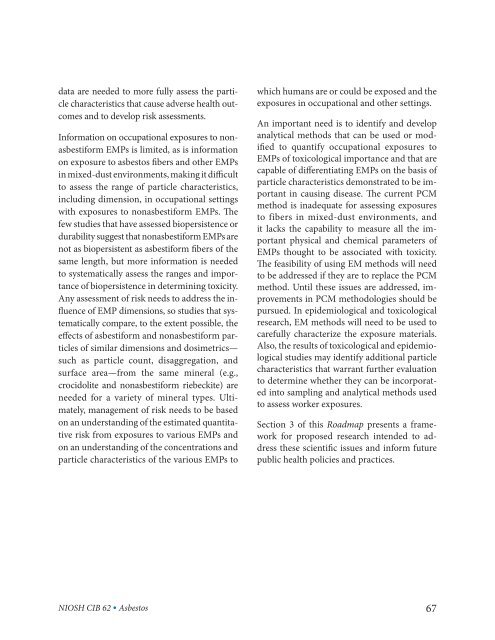Asbestos Fibers and Other Elongate Mineral Particles: State of the ...
Asbestos Fibers and Other Elongate Mineral Particles: State of the ...
Asbestos Fibers and Other Elongate Mineral Particles: State of the ...
- No tags were found...
Create successful ePaper yourself
Turn your PDF publications into a flip-book with our unique Google optimized e-Paper software.
data are needed to more fully assess <strong>the</strong> particle<br />
characteristics that cause adverse health outcomes<br />
<strong>and</strong> to develop risk assessments.<br />
Information on occupational exposures to non-<br />
asbestiform EMPs is limited, as is information<br />
on exposure to asbestos fibers <strong>and</strong> o<strong>the</strong>r EMPs<br />
in mixed-dust environments, making it difficult<br />
to assess <strong>the</strong> range <strong>of</strong> particle characteristics,<br />
including dimension, in occupational settings<br />
with exposures to nonasbestiform EMPs. The<br />
few studies that have assessed biopersistence or<br />
durability suggest that nonasbestiform EMPs are<br />
not as biopersistent as asbestiform fibers <strong>of</strong> <strong>the</strong><br />
same length, but more information is needed<br />
to systematically assess <strong>the</strong> ranges <strong>and</strong> importance<br />
<strong>of</strong> biopersistence in determining toxicity.<br />
Any assessment <strong>of</strong> risk needs to address <strong>the</strong> influence<br />
<strong>of</strong> EMP dimensions, so studies that systematically<br />
compare, to <strong>the</strong> extent possible, <strong>the</strong><br />
effects <strong>of</strong> asbestiform <strong>and</strong> nonasbestiform particles<br />
<strong>of</strong> similar dimensions <strong>and</strong> dosimetrics—<br />
such as particle count, disaggregation, <strong>and</strong><br />
surface area—from <strong>the</strong> same mineral (e.g.,<br />
crocidolite <strong>and</strong> nonasbestiform riebeckite) are<br />
needed for a variety <strong>of</strong> mineral types. Ultimately,<br />
management <strong>of</strong> risk needs to be based<br />
on an underst<strong>and</strong>ing <strong>of</strong> <strong>the</strong> estimated quantitative<br />
risk from exposures to various EMPs <strong>and</strong><br />
on an underst<strong>and</strong>ing <strong>of</strong> <strong>the</strong> concentrations <strong>and</strong><br />
particle characteristics <strong>of</strong> <strong>the</strong> various EMPs to<br />
NIOSH CIB 62 • <strong>Asbestos</strong><br />
which humans are or could be exposed <strong>and</strong> <strong>the</strong><br />
exposures in occupational <strong>and</strong> o<strong>the</strong>r settings.<br />
An important need is to identify <strong>and</strong> develop<br />
analytical methods that can be used or modified<br />
to quantify occupational exposures to<br />
EMPs <strong>of</strong> toxicological importance <strong>and</strong> that are<br />
capable <strong>of</strong> differentiating EMPs on <strong>the</strong> basis <strong>of</strong><br />
particle characteristics demonstrated to be important<br />
in causing disease. The current PCM<br />
method is inadequate for assessing exposures<br />
to fibers in mixed-dust environments, <strong>and</strong><br />
it lacks <strong>the</strong> capability to measure all <strong>the</strong> important<br />
physical <strong>and</strong> chemical parameters <strong>of</strong><br />
EMPs thought to be associated with toxicity.<br />
The feasibility <strong>of</strong> using EM methods will need<br />
to be addressed if <strong>the</strong>y are to replace <strong>the</strong> PCM<br />
method. Until <strong>the</strong>se issues are addressed, improvements<br />
in PCM methodologies should be<br />
pursued. In epidemiological <strong>and</strong> toxicological<br />
research, EM methods will need to be used to<br />
carefully characterize <strong>the</strong> exposure materials.<br />
Also, <strong>the</strong> results <strong>of</strong> toxicological <strong>and</strong> epidemiological<br />
studies may identify additional particle<br />
characteristics that warrant fur<strong>the</strong>r evaluation<br />
to determine whe<strong>the</strong>r <strong>the</strong>y can be incorporated<br />
into sampling <strong>and</strong> analytical methods used<br />
to assess worker exposures.<br />
Section 3 <strong>of</strong> this Roadmap presents a framework<br />
for proposed research intended to address<br />
<strong>the</strong>se scientific issues <strong>and</strong> inform future<br />
public health policies <strong>and</strong> practices.<br />
67

















